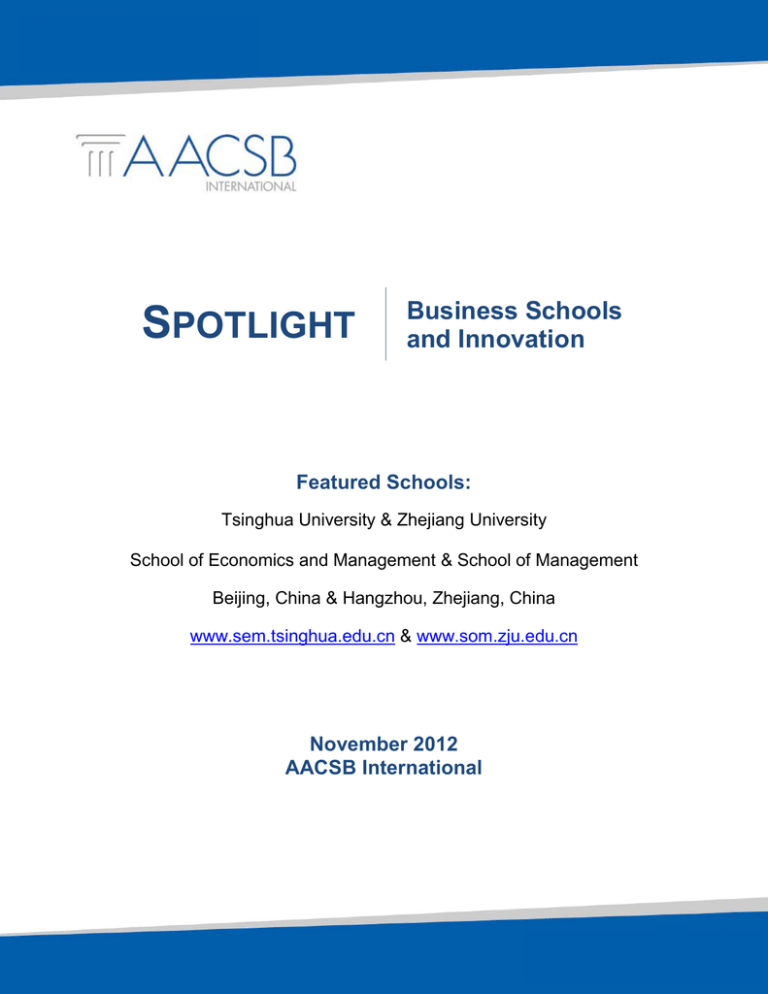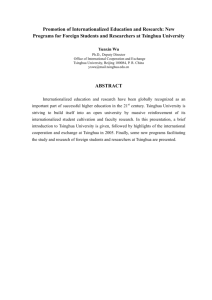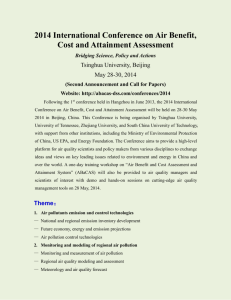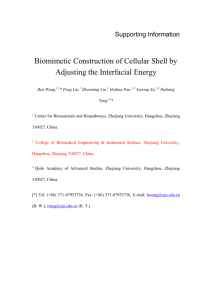
SPOTLIGHT
Business Schools
and Innovation
Featured Schools:
Tsinghua University & Zhejiang University
School of Economics and Management & School of Management
Beijing, China & Hangzhou, Zhejiang, China
www.sem.tsinghua.edu.cn & www.som.zju.edu.cn
November 2012
AACSB International
SPOTLIGHT
|
Business Schools & Innovation
Tsinghua & Zhejiang Universities
|
2
China’s National Innovation Institutes
The rise of China as an economic power over the last few decades has been the subject of much
scholarly and popular discussion. However, in recent years even China’s own leaders have expressed
1
concern as to the sustainability of its remarkable pace of economic growth. As recently as February of
this year, a joint research report by a team from the World Bank and the Development Research Center
of China’s State Council recommended that, among other things, China should accelerate the pace of
open innovation in order to attain its vision of becoming a high-income nation by 2030. In particular, the
report notes that “[t]he speed with which advanced technologies diffuse and the capacity to innovate will
be keyed to the availability of a vast range of technical and soft skills, for example, management,
research, design and production, effectively harnessing IT support, and marketing and customer
relationships.”
2
As many other nations around the world can attest, developing such innovation is easier said than done.
China’s national innovation development system, however, already has a head start in this regard in the
form of a network of research institutes tied to top-flight university-based business schools throughout the
country, whose efforts are devoted to various aspects of promoting innovation. The two most significant of
these institutes are the Research Center for Technological Innovation (RCTI) at Tsinghua University’s
School of Economics and Management (SEM) in Beijing, and the National Institute for Innovation
Management (NIIM), based at the School of Management of Zhejiang University in Hangzhou, the
provincial capital of Zhejiang Province.
Foundation and Mission
Tsinghua and Zhejiang Universities were both among the first nine universities selected by China’s
Ministry of Education for the “985 Program.” This program, which was begun in May of 1998 and has
subsequently expanded to include nearly 40 universities, is intended to give the top Chinese institutions a
st
resource boost, with the goal of promoting a group of “world-class universities for the 21 century” within
3
the country. While both the RCTI and NIIM have existed in some form prior to the establishment of this
program, the development of their current incarnations was supported in part by 985 Program funding.
The Ministry of Education has designated both as national Key Research Bases.
© AACSB International. All Rights Reserved.
SPOTLIGHT
|
Business Schools & Innovation
Tsinghua & Zhejiang Universities
|
3
The RCTI was founded in 2000, with a mission to provide theoretical and operational support for China’s
4
national innovation strategies through high-quality research and international cooperation, while the
modern form of the NIIM developed over time from the consolidation of several smaller institutes at
Zhejiang University. Dr. Zheng Gang, Program Director of the Master of Global Innovation Management
(MGIM) at Zhejiang’s School of Management, says that the NIIM’s primary mission is to function as a
research platform to cultivate excellence in the field of innovation management. He also notes the close
working relationship the NIIM has with the RCTI, as the two have different, though complementary, areas
of emphasis. Being based in a business-friendly city like Hangzhou, he says, it is natural that the NIIM is
primarily focused on company-level research, while the policy-level focus of the work of the RCTI is wellsuited to their location in the national capital. Both the RCTI and NIIM similarly fulfill their missions
through a variety of activities, including research, instruction, outreach and dissemination.
Building Innovation through Research
The RCTI primarily serves as a national “think tank” on topics relating to its five primary research groups,
which include: the Management of Technological Innovation Research Group, the Management of HiTech Entrepreneurship Research Group, the Technology Strategy and Policy Research Group, the
5
Innovation and Entrepreneurship Practice Laboratory, and the Sustainable Innovation Laboratory. The
center also works hand-in-hand with Tsinghua University’s International Technology Transfer Center
(ITTC), which works to help Chinese firms commercialize technologies and products for both Chinese and
6
international markets. The RCTI maintains numerous databases that contain the various research
projects and publications of its staff.
7
Staff of the Research Center for Technological Innovation (RCTI)
© AACSB International. All Rights Reserved.
SPOTLIGHT
|
Business Schools & Innovation
Tsinghua & Zhejiang Universities
|
4
One of the primary strengths of the NIIM lies in its research,
according to Dr. Zheng, in line with the mission for the
institute to serve as a producer of practical knowledge in
the area of promoting innovation in Chinese companies. He
notes that the NIIM is well-known for its case research on
local firms and entrepreneurial ventures, and that its peerreviewed academic research in Chinese innovation
management has contributed to the development of
innovation policy at both the central and local government
levels. NIIM also maintains a number of research
databases, such as the Chinese Enterprise Innovation
Case Database and the Chinese Innovative Economy
Database, to organize and store the fruits of its labor.
Similarly to the RCTI, the NIIM operates six thematically
based sub-institutes, which include: Global Manufacturing and Innovation; Innovation Management and
Policy; Service Innovation and Development; E-Commerce and Emerging Industries; Innovation and
Management of Nonprofit Organizations; and Knowledge, Patents and Standards Strategies. Each of
these sub-institutes has three to five professors and/or doctoral researchers whose interests coincide with
its theme, according to Dr. Zheng, working to produce original research that serves the mission of the
NIIM under the coordination of the NIIM’s central administration.
In 2007, the NIIM began expanding the national innovation network within China by establishing a remote
branch at the University of Electronic Science and Technology of China (UESTC) in Chengdu, the capital
city of Sichuan Province. A year later, a second NIIM branch was established at the Ningbo Institute of
Technology of Zhejiang University (NIT) in Ningbo, Zhejiang Province. These remote branches of the
NIIM coordinate their local efforts with those of the main institute in Hangzhou, says Dr. Zheng, and carry
out research in accordance with NIIM standards and objectives.
Building Innovation through Instruction
In addition to research, both the RCTI and the NIIM conduct a number of courses and programs for
graduate students at both master’s and doctoral levels, in key disciplinary studies. The faculty of the RCTI
and its predecessors at Tsinghua SEM have trained more than 500 graduate students, including 50
8
PhDs, over the last 30 years. Moreover, the RCTI has developed curricula for nearly 30 graduate-level
© AACSB International. All Rights Reserved.
SPOTLIGHT
|
Business Schools & Innovation
Tsinghua & Zhejiang Universities
|
5
courses in innovation and entrepreneurial management, all fed directly from the research undertaken by
the center.
9
The NIIM faculty run several specialist master’s programs, as well as overseeing doctoral student
research, according to Dr. Zheng. He says that the institute hosts two to four post-doctoral research
stations as well. Dr. Zheng goes on to state that the NIIM has trained over 200 master’s, PhD, and postdoctoral researchers over its lifetime, many of whom go on to bring the value of their education to careers
in industry and government. The NIIM also maintains a Chinese Thesis Database for Innovation
Management to store the results of their students’ research efforts.
Building Innovation through Outreach and Dissemination
In addition to their research and teaching programs, the RCTI and the NIIM also conduct a number of
activities aimed at outreach and dissemination of their work. Dr. Li Jinzhen, Assistant Director of the
RCTI, says that on October 18, 2004, the 2
nd
international conference of the Global Network for
Economics of Learning, Innovation, and Competence Building Systems (GLOBELICS)
10
took place in
Tsinghua University, organized by the RCTI, attended by over 100 foreign researchers and 103 Chinese
th
researchers. He likewise notes that on November 9, 2012, the 10 GLOBELICS International Conference
took place in Zhejiang University, organized by the NIIM. Dr. Li says the conference has raised the
publicity and awareness of China’s technological innovation in the world.
Both the RCTI and NIIM have hosted several annual conferences of other such organizations as well,
including the International Symposium on Management of Technology (ISMOT),
11
and workshops of
China’s Innovation Circles and Academy - a Network on Learning, Innovation and Competence Systems
(CICALICS, China’s national network of GLOBELICS).
12
Dr. Li recounts that a special guest professor of
the RCTI, Dr. Bengt-Åke Lundvall, has promoted the CICALICS network based in the RCTI, and that the
RCTI has built up this platform for international academic interactions from 2005 to the present.
The NIIM hosts several annual forums with broad national audiences, including the Chinese Innovation
Forum for Young Scholars, the Zijin Innovation Forum, and the Enterprise Forum for Indigenous
Innovation. In addition, the institute holds a twice-monthly Innovation Management Forum, which is more
focused on firms and audiences local to the Hangzhou area. Dr. Zheng also states that one goal of the
NIIM is to increase the current level of its consulting activities with Chinese firms and government
agencies, with the aim of building alternate revenue streams and becoming more self-sustaining over
time.
Both the RCTI and the NIIM have worked to integrate themselves into the international research
community, to the benefit of their missions. The Sustainable Innovation Laboratory at the RCTI is
© AACSB International. All Rights Reserved.
SPOTLIGHT
|
Business Schools & Innovation
Tsinghua & Zhejiang Universities
|
6
affiliated with the Base of the Pyramid (BOP) Learning Lab network of the Johnson Graduate School of
Management at Cornell University, giving the center access to resources and research from around the
world.
13
Additionally, according to Dr. Li, since 2002 the RCTI has been the institutional representative
from mainland China that participates in the Global Entrepreneur Monitor (GEM) project. The GEM
project, initiated jointly in 1999 by London Business School and Babson College, aims at bringing
together the most distinct and outstanding innovation researchers from all over the globe to study the
relationships between innovation, entrepreneurship and economic growth in a comparative, crossnational fashion.
14
RCTI has been contributing its research results as part of the ‘Global Entrepreneur
Monitor (GEM) China’ every year since, Dr. Li says.
The NIIM hosts three joint research centers with national and international organizations. These include
the Global Manufacturing and Innovation Management Joint Research Centre with Institute for
Manufacturing (IfM) at Cambridge University,
15
and two centers focused on Innovation Management and
Sustainable Competitiveness: one with the Haier Group,
Containers (CIMC) Group, Ltd.
17
16
and one with the China Marine International
The Haier Group’s center provides a platform for development of Total
Innovation Management (TIM) theory and practice, the construction of Enterprise Innovation Systems
(EIS), and R&D manager training, while the CIMC Group’s center focuses on implementation and
evaluation of technological innovation management.
18
The international audiences these organizations reach allow such research and dissemination activities to
have impact both within and beyond China, states Dr. Zheng, by opening the conversation about
innovation management in the Chinese context to CEOs, opinion-makers, governments and academics
alike. Ultimately, as the World Bank-Development Research Center joint report indicates, “[t]he success
of China’s innovation policy will depend on how effectively all branches of the research and innovation
network (research institutes, universities, central and local governments, state and private enterprises)
function together and how these efforts are leveraged internationally through global networks.”
19
Acknowledgements: AACSB International is grateful for the assistance of Dr. ZHENG Gang, Deputy Chair
of Department of Management Science and Engineering, and Director of the Master of Global Innovation
Management Program (MGIM) at Zhejiang University, and of Dr. LI Jizhen, Associate Professor of
Innovation and Entrepreneurship at Tsinghua University and Assistant Director of the RCTI.
© AACSB International. All Rights Reserved.
SPOTLIGHT
|
Business Schools & Innovation
Tsinghua & Zhejiang Universities
|
7
End Notes
1
Bloomberg News. (2011) “China Cuts Economic Growth Target as Premier Wen Calls for Sustainability.”
Bloomberg News, February 27, 2011. Electronic document, http://www.bloomberg.com/news/2011-02-27/chinacuts-economic-growth-target-as-premier-wen-calls-for-sustainability.html, accessed November 1, 2012.
2
World Bank. (2012) China 2030: Building a Modern, Harmonious, and Creative High-Income Society. A joint report of
the World Bank and the Chinese State Council Development Research Center. Electronic document, http://wwwwds.worldbank.org/external/default/WDSContentServer/WDSP/IB/2012/02/28/000356161_20120228001303/Rendered
/PDF/671790WP0P127500China020300complete.pdf, accessed November 1, 2012, p. 163.
3
China Education Center, Ltd. (2012) Project 211 and 985 web page. Electronic document,
http://www.chinaeducenter.com/en/cedu/ceduproject211.php, accessed November 1, 2012.
4
Research Center for Technological Innovation, Tsinghua University. (2012) RCTI Overview web page. Electronic
document, http://www.innovation.tsinghua.edu.cn/cn/Release/review.asp?id=1, accessed November 6, 2012.
5
Research Center for Technological Innovation, Tsinghua University. (2012) RCTI Organization and Key
Management Personnel web page. Electronic document,
http://www.innovation.tsinghua.edu.cn/cn/Release/review.asp?id=4, accessed November 5, 2012.
6
Couto Soares, Maria Clara. (2010) Final Technical Report (September 2007 to October 2010): Research ProjectNational Innovation Systems of BRICS Countries. RedeSist-Economics Institute, Federal University of Rio de Janeiro.
Electronic document, http://idl-bnc.idrc.ca/dspace/bitstream/10625/46244/1/132736.pdf, accessed November 1,
2012, p. 30.
7
Research Center for Technological Innovation, Tsinghua University. (2012) RCTI Innovation, Entrepreneurship,
and Technology database web pages. Electronic documents,
http://www.innovation.tsinghua.edu.cn/cn/Release/list.asp?id=37,
http://www.innovation.tsinghua.edu.cn/cn/Release/list.asp?id=38, and
http://www.innovation.tsinghua.edu.cn/cn/Release/list.asp?id=39, respectively, accessed November 6, 2012.
8
Research Center for Technological Innovation, Tsinghua University. (2012) Graduate Education web page.
Electronic document, http://www.innovation.tsinghua.edu.cn/cn/Release/review.asp?id=112, accessed November
6, 2012.
9
Research Center for Technological Innovation, Tsinghua University. (2012) New Courses web page. Electronic
document, http://www.innovation.tsinghua.edu.cn/cn/Release/review.asp?id=113, accessed November 6, 2012.
10
th
National Institute for Innovation Management, Zhejiang University. (2012) GLOBELICS 2012: The 10 GLOBELICS
International Conference web page. Electronic document, http://www.som.zju.edu.cn/niim/globelics/, accessed
November 2, 2012.
11
National Institute for Innovation Management, Zhejiang University. (2012) Leveraging Innovation Capability
toward Innovative Firm: ISMOT 2012 web page. Electronic document, http://www.som.zju.edu.cn/niim/ismot/,
accessed November 2, 2012.
12
School of Economics and Management, Tsinghua University. (2011) Call for Papers—CICALICS Workshop 2011:
Innovation Systems in Transformation of Economic Development Pattern. Tsinghua SEM Announcements web
page, March 14, 2011. Electronic document,
http://www.sem.tsinghua.edu.cn/portalweb/appmanager/portal/semEN;SEMPORTALJSESSIONID=p7pWQJ0GnnH
YV2h8v81mf1GhXLvLvQbg2pzf8QYY9n2fmpdrKFc8!29296030?_nfpb=true&_windowLabel=T322008885512713035
08946&u=Annoucements%2F42557.htm%3Ftarget%3Dno&_pageLabel=P8800288551271303403795, accessed
November 2, 2012.
13
See Johnson Graduate School of Management, Cornell University. (2012) Center for Sustainable Global
Enterprise, Tsinghua School of Economics and Management web page. Electronic document,
http://www.johnson.cornell.edu/Center-for-Sustainable-Global-Enterprise/Partnerships/Tsinghua-School-ofEconomics-and-Management-SEM.aspx, accessed November 6, 2012; and also Research Center for Technological
Innovation, Tsinghua University. (2012) Sustainable Innovation Laboratory web page. Electronic document,
http://www.innovation.tsinghua.edu.cn/cn/Release/review.asp?id=114, accessed November 6, 2012.
14
Global Entrepreneurship Monitor. (2012) What Is GEM? Web page. Electronic document,
http://www.gemconsortium.org/What-is-GEM, accessed November 12, 2012.
© AACSB International. All Rights Reserved.
SPOTLIGHT
|
Business Schools & Innovation
15
Tsinghua & Zhejiang Universities
|
8
National Institute for Innovation Management, Zhejiang University. (2012) Zhejiang University-Cambridge
University Global Manufacturing and Innovation Management Joint Research Centre web page. Electronic
document, http://www.som.zju.edu.cn/niim/base/jianqiao.php, accessed November 5, 2012.
16
National Institute for Innovation Management, Zhejiang University. (2012) Zhejiang University-Haier Group Joint
Research Center for Innovation Management and Sustainable Competitiveness web page. Electronic document,
http://www.som.zju.edu.cn/niim/base/haier.php, accessed November 5, 2012.
17
National Institute for Innovation Management, Zhejiang University. (2012) Zhejiang University and CIMC Joint
Research Center for Innovation Management and Sustainable Competitiveness web page. Electronic document,
http://www.som.zju.edu.cn/niim/base/zhongji.php, accessed November 5, 2012.
18
National Institute for Innovation Management, Zhejiang University. (2011) National Institute for Innovation
Management informational brochure. P. 18-19.
19
World Bank. (2012) China 2030: Building a Modern, Harmonious, and Creative High-Income Society. A joint report of
the World Bank and the Chinese State Council Development Research Center. Electronic document, http://wwwwds.worldbank.org/external/default/WDSContentServer/WDSP/IB/2012/02/28/000356161_20120228001303/Rendered
/PDF/671790WP0P127500China020300complete.pdf, accessed November 1, 2012, p. 38.
© AACSB International. All Rights Reserved.




